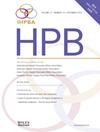Robotic pancreatectomy for pancreatic adenocarcinoma: evolving trends in patient selection and practice patterns across a decade
IF 2.4
3区 医学
Q2 GASTROENTEROLOGY & HEPATOLOGY
引用次数: 0
Abstract
Background
Robotic surgery has been developed as an additional minimally invasive approach to pancreatectomy. We assessed case selection and perioperative outcomes in patients undergoing robotic pancreatectomy for pancreatic adenocarcinoma over time.
Methods
The National Cancer Database (2010–2019) was queried to identify all pancreatic adenocarcinoma patients that underwent robotic pancreatoduodenectomy (RPD) or distal pancreatectomy (RDP). Two periods were established: Early cohort (2010–2014) and Modern cohort (2015–2019).
Results
Of 2245 patients who underwent RPD or RDP, 78.4 % of RPD and 77.6 % of RDP were in the Modern cohort. Robotic approach increased from 2010 to 2019 (RPD: 1.1 %–7.5 %, RDP: 2.2 %–19.4 %; both p < 0.001). Compared to Early, Modern RPD patients were more likely to have non-private insurance (68.5 % vs. 58.7 %), and both RPD (47.0 % vs. 23.4 %) and RDP (47.3 % vs. 32.1 %) patients were more frequently treated in non-academic hospitals (all p < 0.01). Shorter LOS was noted in the Modern RPD (6 vs. 8 days) and RDP cohorts (5 vs. 6 days, both p < 0.001), without differences in readmission/mortality. In RPD and RDP, no differences in overall survival were observed between the eras.
Conclusions
Robotic pancreatectomy for pancreatic adenocarcinoma has increased over time with greater inclusion of patients and hospital types while outcomes have remained similar.
机器人胰腺切除术治疗胰腺腺癌:十年来患者选择和实践模式的演变趋势。
背景:机器人手术已经发展成为胰腺切除术的一种额外的微创方法。随着时间的推移,我们评估了接受机器人胰腺切除术治疗胰腺腺癌患者的病例选择和围手术期结果。方法:查询国家癌症数据库(2010-2019),以确定所有接受机器人胰十二指肠切除术(RPD)或远端胰腺切除术(RDP)的胰腺腺癌患者。研究分为早期队列(2010-2014)和现代队列(2015-2019)两个阶段。结果:在2245例接受RPD或RDP的患者中,78.4%的RPD和77.6%的RDP在现代队列中。机器人方法从2010年到2019年有所增加(RPD: 1.1% - 7.5%, RDP: 2.2% - 19.4%;p均< 0.001)。与早期相比,现代RPD患者更有可能拥有非私人保险(68.5%比58.7%),RPD(47.0%比23.4%)和RDP(47.3%比32.1%)患者在非学术医院的治疗频率更高(均p < 0.01)。现代RPD组(6天vs 8天)和RDP组(5天vs 6天,p均< 0.001)的LOS较短,再入院/死亡率无差异。在RPD和RDP中,两组患者的总生存率无差异。结论:胰腺腺癌的机器人胰腺切除术随着时间的推移而增加,包括更多的患者和医院类型,但结果保持相似。
本文章由计算机程序翻译,如有差异,请以英文原文为准。
求助全文
约1分钟内获得全文
求助全文
来源期刊

Hpb
GASTROENTEROLOGY & HEPATOLOGY-SURGERY
CiteScore
5.60
自引率
3.40%
发文量
244
审稿时长
57 days
期刊介绍:
HPB is an international forum for clinical, scientific and educational communication.
Twelve issues a year bring the reader leading articles, expert reviews, original articles, images, editorials, and reader correspondence encompassing all aspects of benign and malignant hepatobiliary disease and its management. HPB features relevant aspects of clinical and translational research and practice.
Specific areas of interest include HPB diseases encountered globally by clinical practitioners in this specialist field of gastrointestinal surgery. The journal addresses the challenges faced in the management of cancer involving the liver, biliary system and pancreas. While surgical oncology represents a large part of HPB practice, submission of manuscripts relating to liver and pancreas transplantation, the treatment of benign conditions such as acute and chronic pancreatitis, and those relating to hepatobiliary infection and inflammation are also welcomed. There will be a focus on developing a multidisciplinary approach to diagnosis and treatment with endoscopic and laparoscopic approaches, radiological interventions and surgical techniques being strongly represented. HPB welcomes submission of manuscripts in all these areas and in scientific focused research that has clear clinical relevance to HPB surgical practice.
HPB aims to help its readers - surgeons, physicians, radiologists and basic scientists - to develop their knowledge and practice. HPB will be of interest to specialists involved in the management of hepatobiliary and pancreatic disease however will also inform those working in related fields.
Abstracted and Indexed in:
MEDLINE®
EMBASE
PubMed
Science Citation Index Expanded
Academic Search (EBSCO)
HPB is owned by the International Hepato-Pancreato-Biliary Association (IHPBA) and is also the official Journal of the American Hepato-Pancreato-Biliary Association (AHPBA), the Asian-Pacific Hepato Pancreatic Biliary Association (A-PHPBA) and the European-African Hepato-Pancreatic Biliary Association (E-AHPBA).
 求助内容:
求助内容: 应助结果提醒方式:
应助结果提醒方式:


